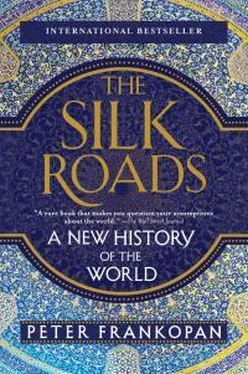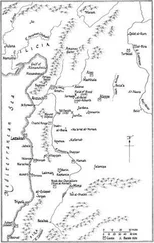Persia was also quaking in the face of cataclysm from the steppes. Its provinces in the east buckled under the onslaught, before collapsing altogether: towns were depopulated; crucial irrigation networks fell into disrepair and broke down as raids took their toll.5 Attacks through the Caucasus were overwhelming, and resulted in prisoners and booty being seized from the cities of Mesopotamia, Syria and Asia Minor. Then in 395 a major long-range attack devastated the cities of the Tigris and Euphrates, reaching as far as Ctesiphon, the capital, before finally being driven back.6
United by a common interest in repelling the barbarian hordes, Persia and Rome now formed a remarkable alliance. To keep the nomads from descending through the Caucasus, a massive fortified wall was constructed, running for nearly 125 miles between the Caspian and Black Seas, protecting the Persian interior from attack and serving as a physical barrier between the ordered world to the south and the chaos to the north. Studded with thirty forts evenly spaced along its length, the wall was also protected by a canal fifteen feet deep. It was a marvel of architectural planning and engineering, built with standardised bricks made in scores of kilns installed on site. The fortification was manned by some 30,000 troops, housed in garrisons that were set back from the wall itself.7 The barrier was just one of several innovative steps taken by the Sasanians to defend Persia’s long northern frontier with the steppe, and to protect vulnerable trading posts such as Merv, which was the first location that would be encountered by attackers coming through the Karakum desert (in what is now Turkmenistan).8
Rome not only agreed to make regular financial contributions to the maintenance of this Persian wall, but also, according to several contemporary sources, supplied soldiers to help defend it.9 In a sign of how past rivalries had been set to one side, in 402 the Emperor Honorius in Constantinople appointed none other than the Shah to act as guardian to his son and heir.10
But by that time it was too late—as far as Rome was concerned. Displacement across the steppes north of the Black Sea had created a perfect storm that led to the empire’s frontiers on the Rhine being overwhelmed. A series of raids in the late fourth century cleaved Rome’s western provinces wide open, with tribal leaders gaining personal kudos from military successes as well as material gains that drew in more followers and gave fresh momentum to further attacks. As the imperial army struggled to make a stand against the attacking hordes, one wave after another crashed through the empire’s defences, leading to the devastation of the province of Gaul. Things went from bad to worse when Alaric, a particularly effective and ambitious leader, marched his tribe of Visigoths down through Italy and camped outside Rome to bully the city into buying him off. As the Senate desperately tried to do so, he grew tired of being stalled, and in 410 stormed and sacked the city.11
Shock resonated across the Mediterranean. In Jerusalem, the news was met with disbelief. “The speaker’s voice failed, and sobs interrupted his speech,” wrote St. Jerome, “the city that had conquered the whole world had itself been conquered…who could believe it? Who could believe that Rome, built up through the ages by the conquest of the world, had fallen, that the mother of nations had become their tomb?”12 At least the city was not torched, wrote the historian Jordanes with the weary resignation of a century’s hindsight.13
Burning or not, Rome’s empire in the west now fell apart. Soon Spain was being ravaged, attacked by tribes such as the Alans, whose homelands lay far away between the Caspian and Black Seas, and whose trade in sable skins had first been carefully charted by commentators writing in China nearly two centuries earlier.14 Another tribal grouping, the Vandals, who had been displaced by the Huns, reached Roman North Africa by the 420s, taking control of the principal city, Carthage, as well as the vibrant and lucrative surrounding provinces that supplied most of the western half of the empire with corn.15
As if this were not bad enough, in the middle of the fifth century, having flushed forward a hotch-potch of tribes—Terevingian Goths, Alans, Vandals, Suevi, Gepids, Neurians, Bastarnians and others besides—the Huns themselves appeared in Europe, led by the most famous figure of late antiquity: Attila.16 The Huns caused pure terror. They are “the seedbed of evil,” wrote one Roman writer, and “exceedingly savage.” Trained from youth to cope with extreme cold, hunger and thirst, they dressed in the skins of field mice that were stitched together; they would eat roots and raw flesh—which would be partially warmed by being placed between their thighs.17 They had no interest in agriculture, noted another, and only wanted to steal from their neighbours, enslaving them in the process: they were like wolves.18 The Huns scarred the cheeks of infant boys when they were born in order to prevent facial hair growing later in life, while they spent so long on horseback that their bodies were grotesquely deformed; they looked like animals standing on their hind legs.19
Although it is tempting to dismiss such comments as signs of bigotry, examinations of skeletal remains show that the Huns practised artificial cranial deformation on their young, bandaging the skull to flatten the frontal and occipital bones by applying pressure to them. This caused the head to grow in a distinctly pointed manner. It was not just the behaviour of the Huns that was terrifyingly out of the ordinary; so was the way they looked.20
The arrival of the Huns spelt serious danger for the eastern half of the Roman Empire, which had thus far been relatively unscathed by the upheavals that devastated much of Europe. The provinces of Asia Minor, Syria and Palestine and Egypt were still intact, as was the magnificent city of Constantinople. Taking no chances, the Emperor Theodosius II surrounded the city with formidable defences, including a huge set of Land Walls, to protect it from attack.
These walls, and the narrow strip of water separating Europe from Asia, proved to be crucial. After setting himself up just to the north of the Danube, Attila ravaged the Balkans for fifteen years, extracting heavy tribute from the government in Constantinople in return for not advancing further, and securing vast amounts of gold. Having squeezed everything he could from the imperial authorities in terms of ransoms and bribes, he advanced west; eventually his progress was checked, not by the armies of Rome, but by a coalition made up of many long-term enemies of the Huns. At the battle of the Catalaunian Plains, in what is now central France, in 451, Attila was defeated by a large force that included an astonishing array of races drawn from the peoples of the steppes. The Hun leader died not long afterwards on his wedding night—not his first. Celebrating excessively, says one contemporary, he “lay down on his back sodden with wine and sleep,” suffered a brain haemorrhage and died in his sleep. “Thus drunkenness brought a shameful end to a king who had won glory in war.”21
* * *
These days, it is voguish to talk of an age of transformation and continuities that followed the sack of Rome—rather than to describe the period as the Dark Ages. And yet, as one modern scholar argues powerfully, the impact of the rape, pillage and anarchy that marked the fifth century as the Goths, Alans, Vandals and Huns rampaged across Europe and North Africa is hard to exaggerate. Literacy levels plummeted; building in stone all but disappeared, a clear sign of collapse of wealth and ambition; long-distance trade that once took pottery from factories in Tunisia as far as Iona in Scotland collapsed, replaced by local markets dealing only with exchange of petty goods; and as measured from pollution in polar ice-caps in Greenland there was a major contraction in smelting work, with levels falling back to those of prehistoric times.22
Читать дальше











